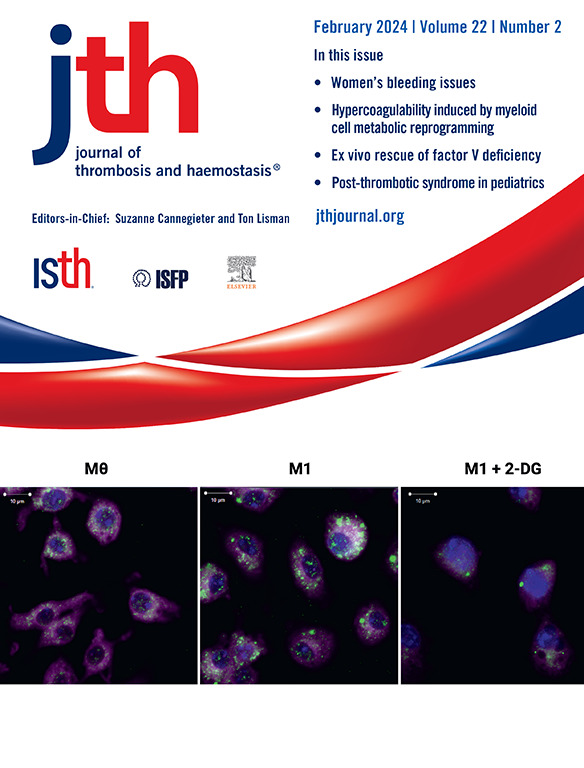Circulating biomarkers and ischemic stroke risk in adults with atrial fibrillation taking anticoagulation: the Reasons for Geographic And Racial Differences in Stroke study
IF 5
2区 医学
Q1 HEMATOLOGY
引用次数: 0
Abstract
Background
Anticoagulation reduces ischemic stroke risk in atrial fibrillation (AF), but “breakthrough” stroke occurs. Blood biomarkers might help identify patients at risk for this, but existing studies are limited in examining few biomarkers in select populations.
Objectives
To determine whether established biomarkers of ischemic stroke risk will be associated with ischemic stroke risk in people with AF on anticoagulation sampled from the general population.
Methods
The REasons for Geographic and Racial Differences in Stroke study is a prospective cohort study of 30 239 Black or White adults aged ≥45 years at enrollment in 2003 to 2007 monitored for stroke. Nine biomarkers were measured at baseline in participants with AF, no prior stroke, and who were taking oral anticoagulation at baseline. Hazard ratios of ischemic stroke were estimated by Cox models adjusted for demographics and stroke risk factors.
Results
Among 713 participants with AF on warfarin (median age 76, 36% female, 17% Black), 67 (9%) developed a first-time ischemic stroke over 12 years. Adjusting for confounders, each SD higher N-terminal pro–B-type natriuretic peptide (NTproBNP), factor VIII, D-dimer, and growth differentiation factor 15 (GDF-15) were positively associated with incident stroke, with hazard ratios ranging from 1.49 (95% CI, 1.11-2.02) for NTproBNP to 1.28 (95% CI, 0.92-1.77) for GDF-15. Associations for D-dimer and GDF-15 did not meet statistical significance.
Conclusion
Biomarkers of atriopathy, coagulation, and vascular inflammation were associated with higher ischemic stroke risk in people with AF on anticoagulation at baseline. Findings highlight new avenues for reducing stroke risk in AF, but a larger study is needed for validation.
房颤患者接受抗凝治疗后的循环生物标志物和缺血性卒中风险:卒中研究中地理和种族差异的原因
背景:抗凝可降低房颤(AF)患者缺血性卒中的风险,但会发生“突破性”卒中。血液生物标记物可能有助于识别有这种风险的患者,但现有的研究仅限于在特定人群中检查少数生物标记物。目的:确定已建立的缺血性卒中风险生物标志物是否与普通人群中抗凝治疗的房颤患者缺血性卒中风险相关。方法:卒中地理和种族差异的原因研究是一项前瞻性队列研究,研究对象为30239名年龄≥45岁的黑人或白人成人,于2003年至2007年进行卒中监测。在基线时测量9项生物标志物,受试者为房颤,既往无卒中,基线时服用口服抗凝剂。缺血性脑卒中的危险比通过Cox模型进行估计,该模型校正了人口统计学和脑卒中危险因素。结果:在713名服用华法林的房颤患者(中位年龄76岁,36%女性,17%黑人)中,67名(9%)在12年内首次发生缺血性卒中。调整混杂因素后,每个SD高n端前b型利钠肽(NTproBNP)、因子VIII、d -二聚体和生长分化因子15 (GDF-15)与卒中事件呈正相关,风险比范围从NTproBNP的1.49 (95% CI, 1.11-2.02)到GDF-15的1.28 (95% CI, 0.92-1.77)。d -二聚体与GDF-15的相关性无统计学意义。结论:心房病变、凝血和血管炎症的生物标志物与基线抗凝治疗的房颤患者缺血性卒中风险升高相关。研究结果强调了降低房颤卒中风险的新途径,但需要更大规模的研究来验证。
本文章由计算机程序翻译,如有差异,请以英文原文为准。
求助全文
约1分钟内获得全文
求助全文
来源期刊
CiteScore
24.30
自引率
3.80%
发文量
321
审稿时长
1 months
期刊介绍:
The Journal of Thrombosis and Haemostasis (JTH) serves as the official journal of the International Society on Thrombosis and Haemostasis. It is dedicated to advancing science related to thrombosis, bleeding disorders, and vascular biology through the dissemination and exchange of information and ideas within the global research community.
Types of Publications:
The journal publishes a variety of content, including:
Original research reports
State-of-the-art reviews
Brief reports
Case reports
Invited commentaries on publications in the Journal
Forum articles
Correspondence
Announcements
Scope of Contributions:
Editors invite contributions from both fundamental and clinical domains. These include:
Basic manuscripts on blood coagulation and fibrinolysis
Studies on proteins and reactions related to thrombosis and haemostasis
Research on blood platelets and their interactions with other biological systems, such as the vessel wall, blood cells, and invading organisms
Clinical manuscripts covering various topics including venous thrombosis, arterial disease, hemophilia, bleeding disorders, and platelet diseases
Clinical manuscripts may encompass etiology, diagnostics, prognosis, prevention, and treatment strategies.

 求助内容:
求助内容: 应助结果提醒方式:
应助结果提醒方式:


